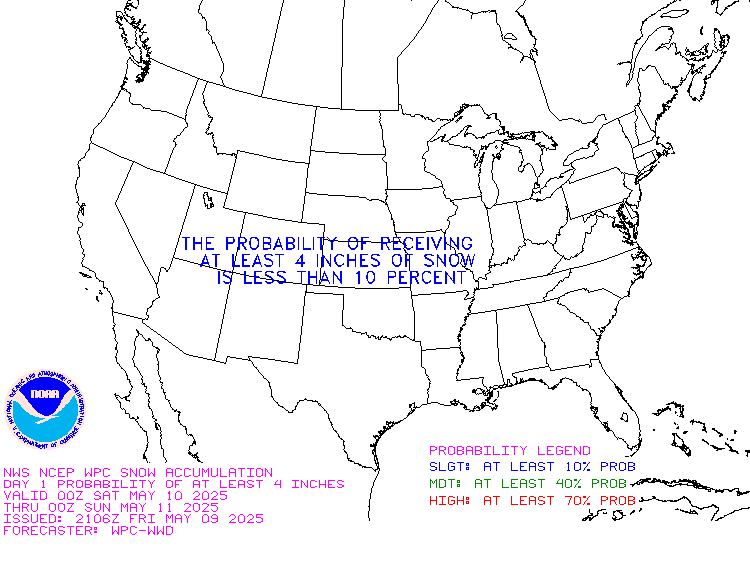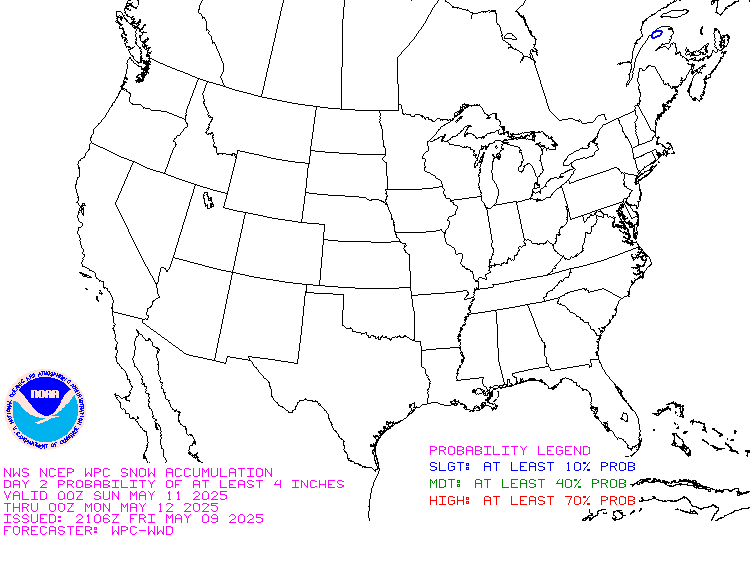This article focuses on what we are paying attention to in the next 48 to 72 hours. The article also includes weather maps for longer-term U.S. outlooks and a six-day World weather outlook which can be very useful for travelers.
First the highlights from the NWS.
Short Range Forecast Discussion
NWS Weather Prediction Center College Park MD
Mon Jan 08 2024
Valid 12Z Mon Jan 08 2024 – 12Z Wed Jan 10 2024…A Major Storm will produce widespread, significant impacts over much of
the U.S. this week……A Major Winter Storm will bring several feet of snow to the Washington
and Oregon Cascades through Tuesday…
Please click on “Read More” below to access the full report issued today.
| Notices: The article on the Updated Outlook for January 2924 can be accessed HERE. What would you like to learn about? Please provide that to me via the comment section at the end of the article. |
Now more detail on the 48-Hour Forecast (It is a 48 to 72 Hour Forecast actually)
Daily weather maps. The Day 1 map updates twice a day and the Day 2 and 3 maps update only once a day. These maps update automatically. But if that does not happen, you can get updates by clicking HERE
TODAY (or late in the day the evening/overnight map will appear) (Key to surface fronts shown on maps and you will then also be able to insert a city name or zip code and get a local NWS forecast).
TOMORROW
NEXT DAY
This animation shows how things may play out over the next 60 hours. To update click here.
The NWS Climate Prediction Center’s: Watches, Warnings, and Advisories plus other information can be found HERE. We post at least one of those updates daily, sometimes both. The Highlights are shown in the lede paragraph of this article.
ATMOSPHERIC RIVERS
This tells us what is approaching the West Coast. Click HERE to update If I have not gotten around to doing the update. Here is some useful information about Atmospheric Rivers.
Continuation of the NWS Short Range Forecast. It is updated by NWS twice a day and these updates can be found here
A deep and dynamic mid-latitude cyclone will organize over the
Central/Southern Plains this morning. Snow will develop in the Plains
today and advance into the Midwest tonight and Tuesday. Bursts of heavy
snow may accumulate up to two inches in an hour, and result in hazardous
travel. A heavy, wet snow will also develop in the interior Northeast
Tuesday afternoon and night. A blizzard is expected in the Plains of
northeast New Mexico, eastern Colorado, the Oklahoma and Texas Panhandles,
western Kansas and southwest Nebraska. Wind gusts as high as 60-70 mph
will create ferocious blizzard conditions with whiteouts. Travel will
become extremely dangerous to impossible. If you must travel, pack a
winter survival kit as wind chills will plummet below zero.There is an Enhanced Risk of Severe Thunderstorms across the central Gulf
Coast tonight into early Tuesday morning. Severe thunderstorms capable of
producing strong wind gusts and tornadoes are expected from southeast
Texas across the central Gulf Coast this afternoon into early Tuesday
morning. This Enhanced Risk of Severe Thunderstorms shifts into parts of
southeastern Alabama, northern Florida and parts of the Carolina
Piedmont/Coastal Plain on Tuesday. Very strong and damaging winds as well
as a few tornadoes will be the main threats.Widespread and potentially significant river and flash flooding are likely
for the central Gulf Coast and Eastern U.S. through early Wednesday.
Powerful onshore winds will lead to widespread coastal flooding along the
eastern Gulf Coast and much of the East Coast. Significant coastal
flooding is likely, especially on the Mid-Atlantic coastline, including
tidal rivers and bays. There’s a Moderate Risk of Excessive Rainfall
leading to Flash Flooding over parts of southeast Louisiana, southern
Mississippi and southwestern Alabama today where several inches of
rainfall may accumulate. The Moderate Risk of Excessive Rainfall shifts
into the Mid-Atlantic on Tuesday between northern Virginia, up the I-95
corridor and into western Massachusetts, where existing snowpack from the
recent snowstorm may cause additional runoff concerns. Widespread wind
gusts in excess of 50 mph are likely in the eastern Gulf Coast, Central
Appalachians, much of the East Coast and New England. Prepare for power
outages.Elsewhere, yet another pair of powerful winter storm systems will cross
the Pacific Northwest tonight and Tuesday night with several feet of heavy
snow and strong winds expected across the Cascades. Blizzard conditions
are likely. Snow levels rise to around 5000′ tonight with an atmospheric
river, but will quickly fall to between 1500 and 2500 feet behind a cold
front on Tuesday, leading to considerable impacts for many mountain passes
with the second storm Tuesday night. Over a foot of snow is likely
(70-90%) in the higher elevations of the Northern Rockies on Tuesday and
Wednesday.
Learn about wave patterns HERE.
Below is the current five-day cumulative forecast of precipitation (Updates can be found HERE)
Ski SnowReports
New Feature – Ski Reports. It is difficult to find reports that auto-update on-screen (and they are very long) but these links will get you to them – If you have additional suggestions make them in the comments section after every Econcurrents Article and we may add those links. We will try to not have too much overlap as that can add to the confusion.
Snow Forecasts. And remember this shows natural snow. Ski resorts also make their own snow.
Day 1

Day 2

Additional snow information can be found here and here. The second link provides animations.
Now we look at Intermediate-Term “Outlook” maps for three time periods. Days 6 – 10, Days 8 – 14, and Weeks 3 and 4. An outlook differs from a forecast based on how NOAA uses these terms in that an “outlook” presents information as deviation from normal and the likelihood of these deviations.
Below are the links to obtain updates and additional information. They are particularly useful if you happen to be reading this article significantly later than when it was published. I always try to provide readers with the source of the information in my articles.
| Days 6 – 10 (shown in Row 1) | Days 8 – 14 (Shown in Row 2) | Weeks 3 and 4 (Shown in Row 3 but updates only on Fridays) |
| https://www.cpc.ncep.noaa. gov/products/predictions/610day/ | https://www.cpc.ncep .noaa.gov/products/predictions/814day/ | https://www.cpc.ncep.noaa.gov/products/predictions/WK34/ |
Showing the actual maps. They should now update automatically. The Week 3 – 4 Outlook only updates on Fridays. So below is what I call the Intermediate-term outlook. On Fridays, it extends out 28 Days. That declines day by day so on Thursday it only looks out 22 days until the next day when the Week 3 – 4 Outlook is updated and this extends the outlook by one additional week.
| 6–
10
|
|
|
| 8–
14 |
|
|
| 3–
4 |
|
|
HAZARDS OUTLOOKS
Click here for the latest complete Day 3 -7 Hazards forecast which updates only on weekdays. Once a week probably Monday or Tuesday I will update the images. I provided the link for readers to get daily updates on weekdays. Use your own judgment to decide if you need to update these images. I update almost all the images Friday Night for the weekend edition of this Weather Report. So normally readers do not need to update these images but if the weather is changing quickly you may want to.
Temperature month to date can be found at https://hprcc.unl.edu/products/maps/acis/MonthTDeptUS.png
Precipitation month to date can be found at https://hprcc.unl.edu/products/maps/acis /MonthPNormUS.png
World Forecast
Below are the Day 1 -3 and 4-6 forecasts for temperature and precipitation. Updates and much additional information can be obtained HERE
World Temperature Anomalies
World Accumulated Precipitation
This information is provided by the University of Maine. They draw upon many different sources. There is a lot of information available at the link provided. I have just provided two useful forecasts. There are probably over a hundred different forecasts available from this source.
Worldwide Tropical Forecast (This is a NOAA Product)
This graphic updates on Tuesdays) If it has not been updated, you can get the update by clicking here Readers will only have to do that if they are reading this article much later than the date of it being published.
Information on Tropical Storms can be found HERE. Western Pacific information can be found HERE.
–
| I hope you found this article interesting and useful. |
–
